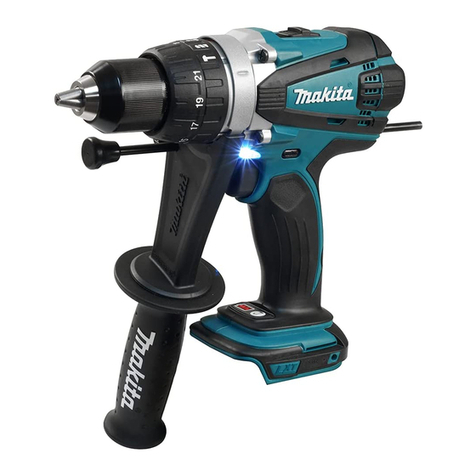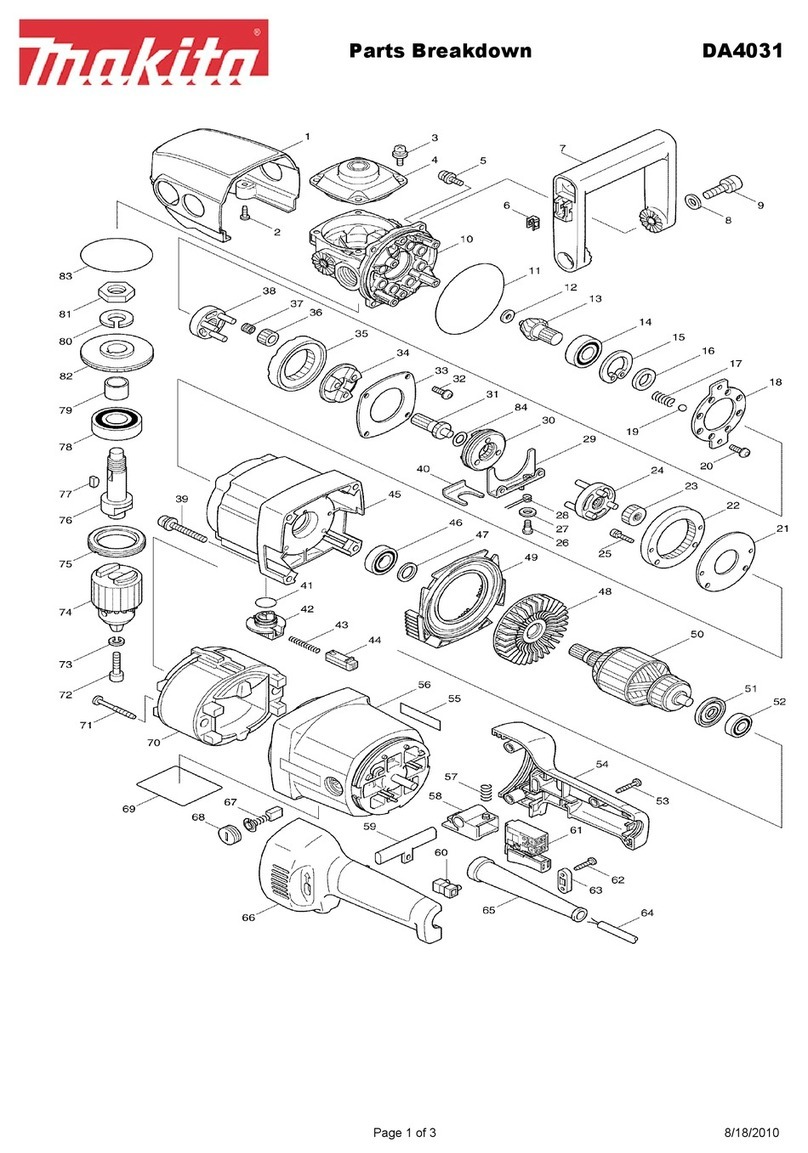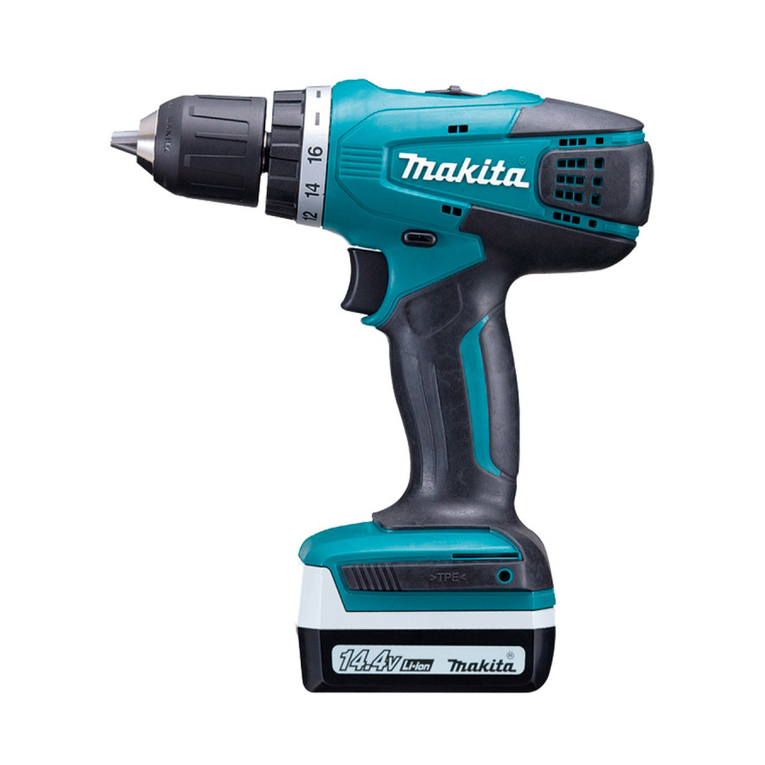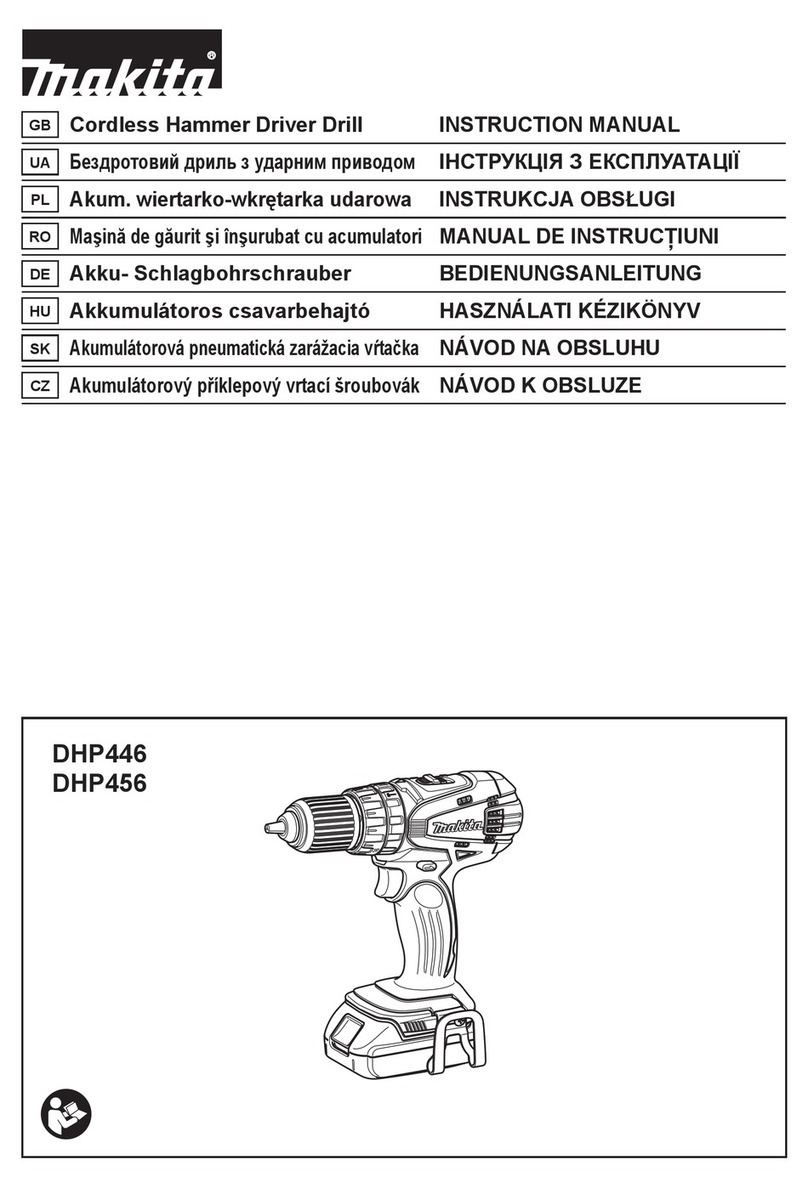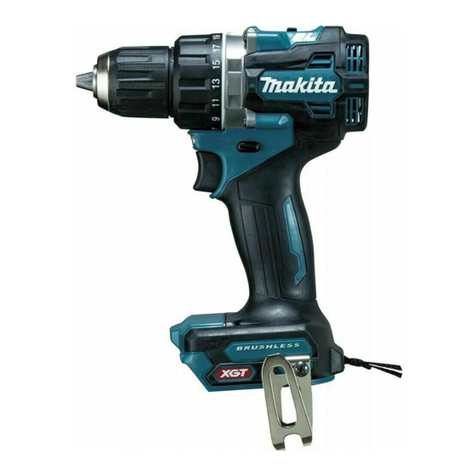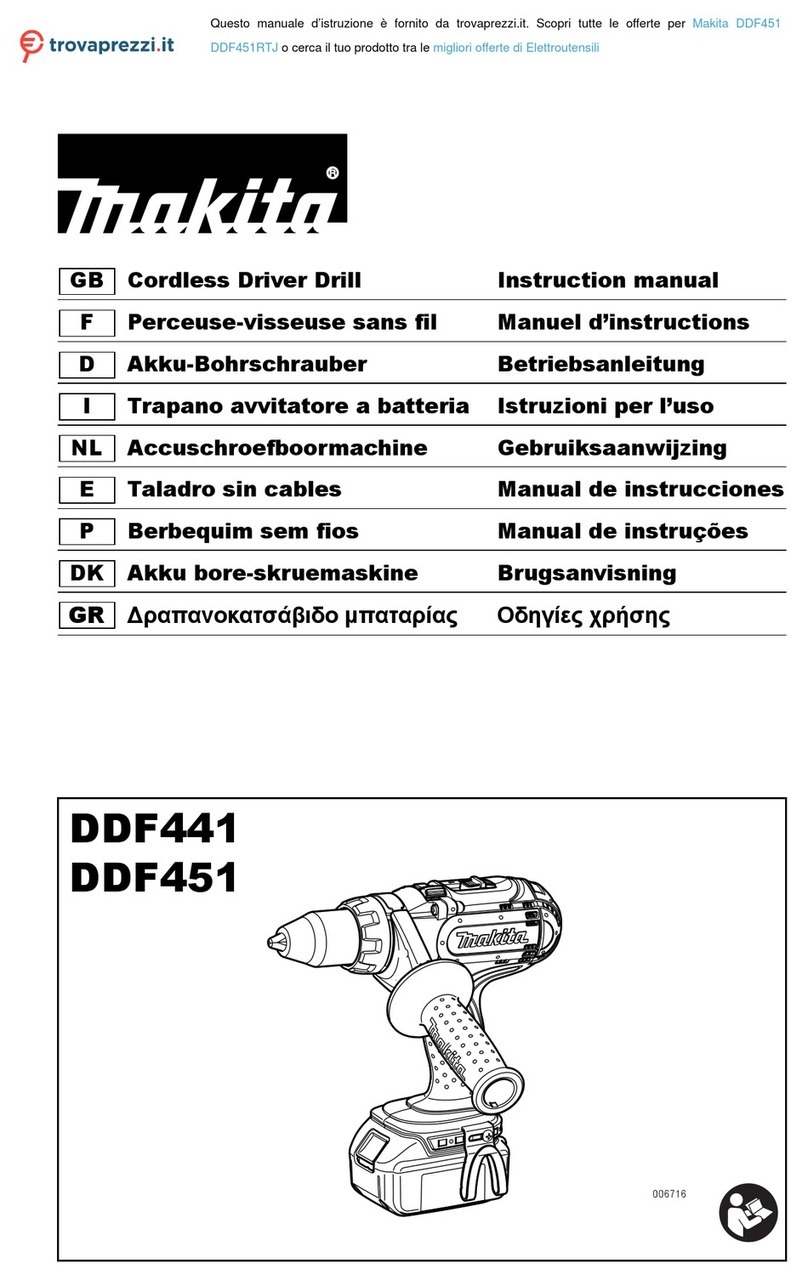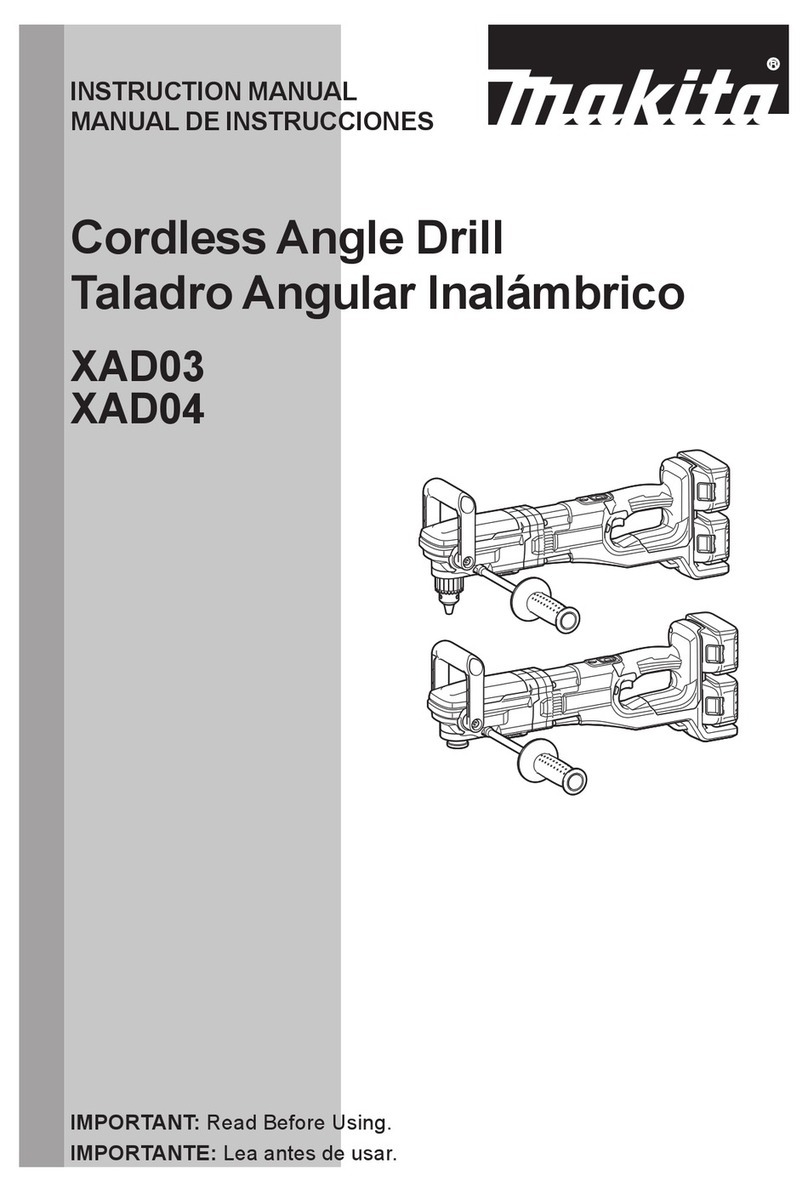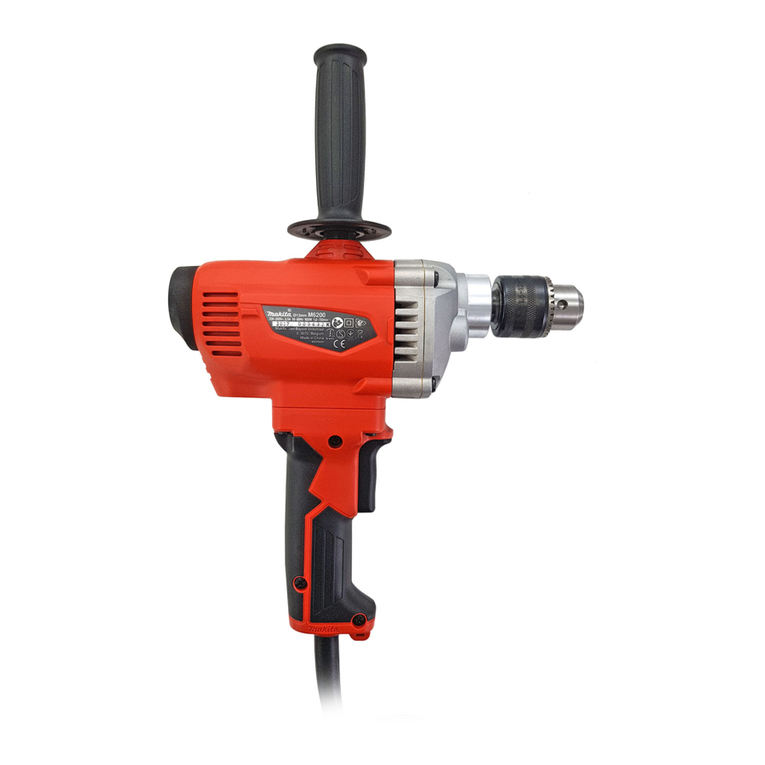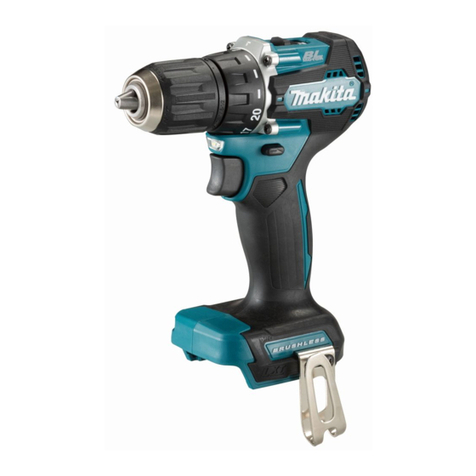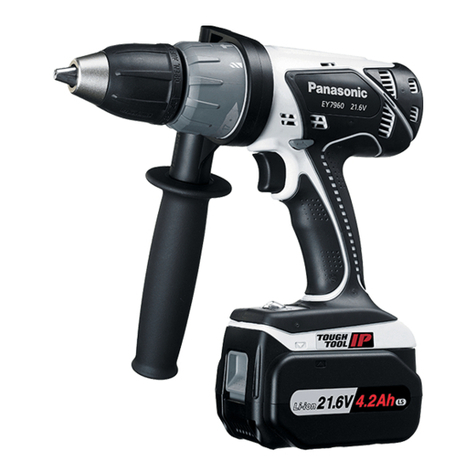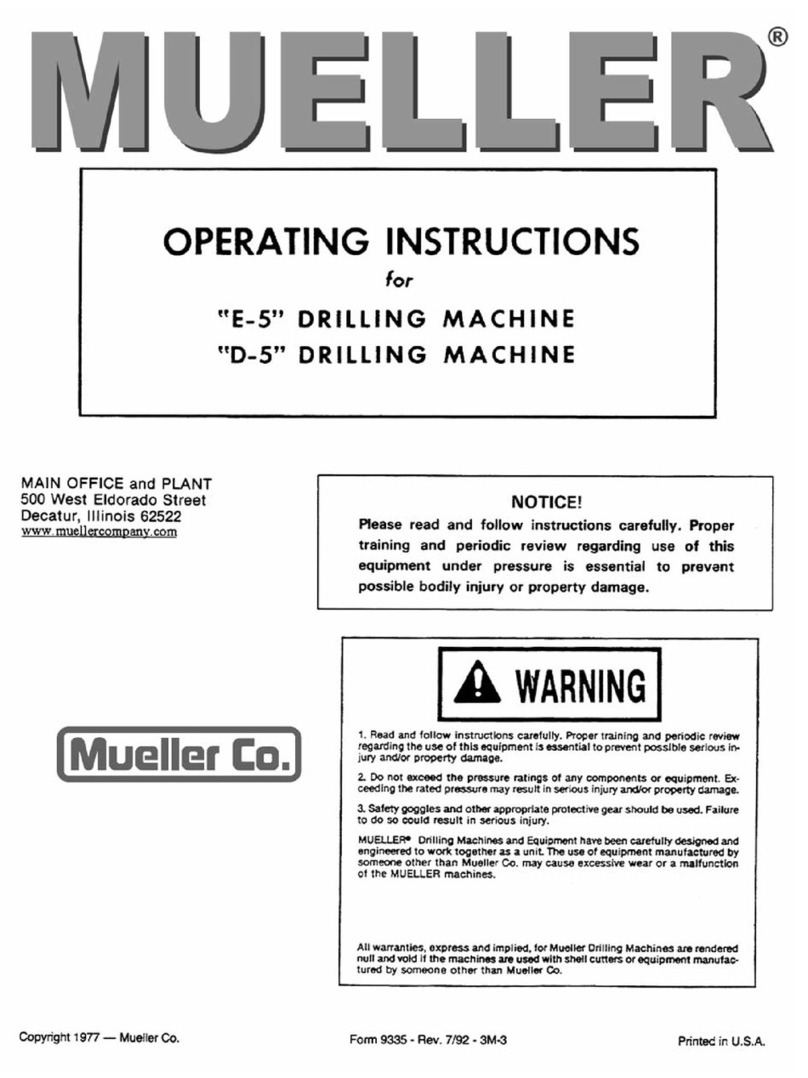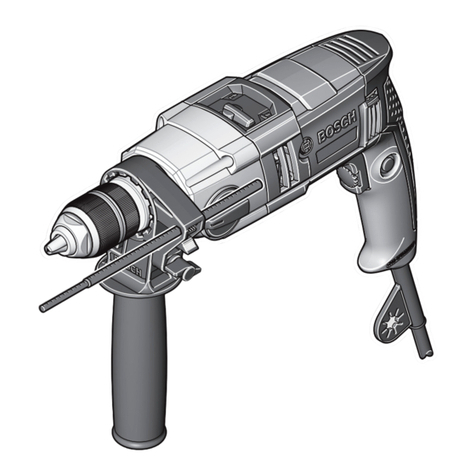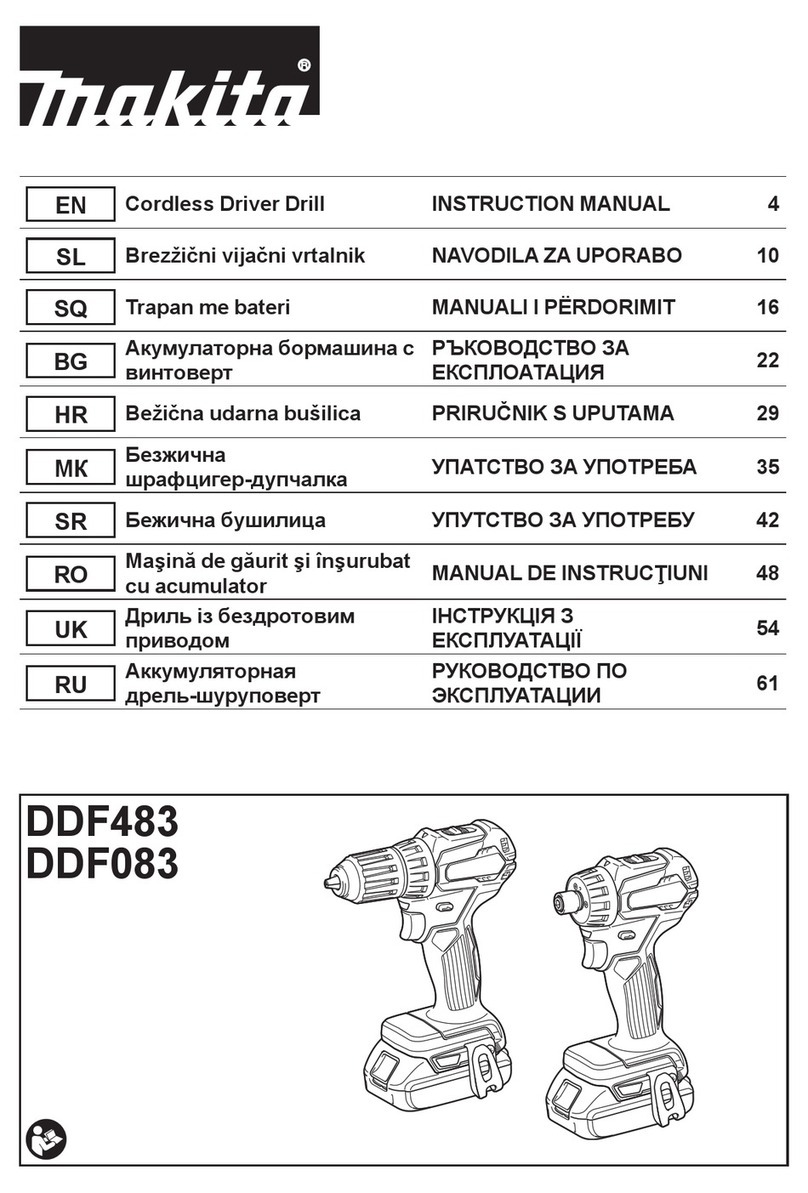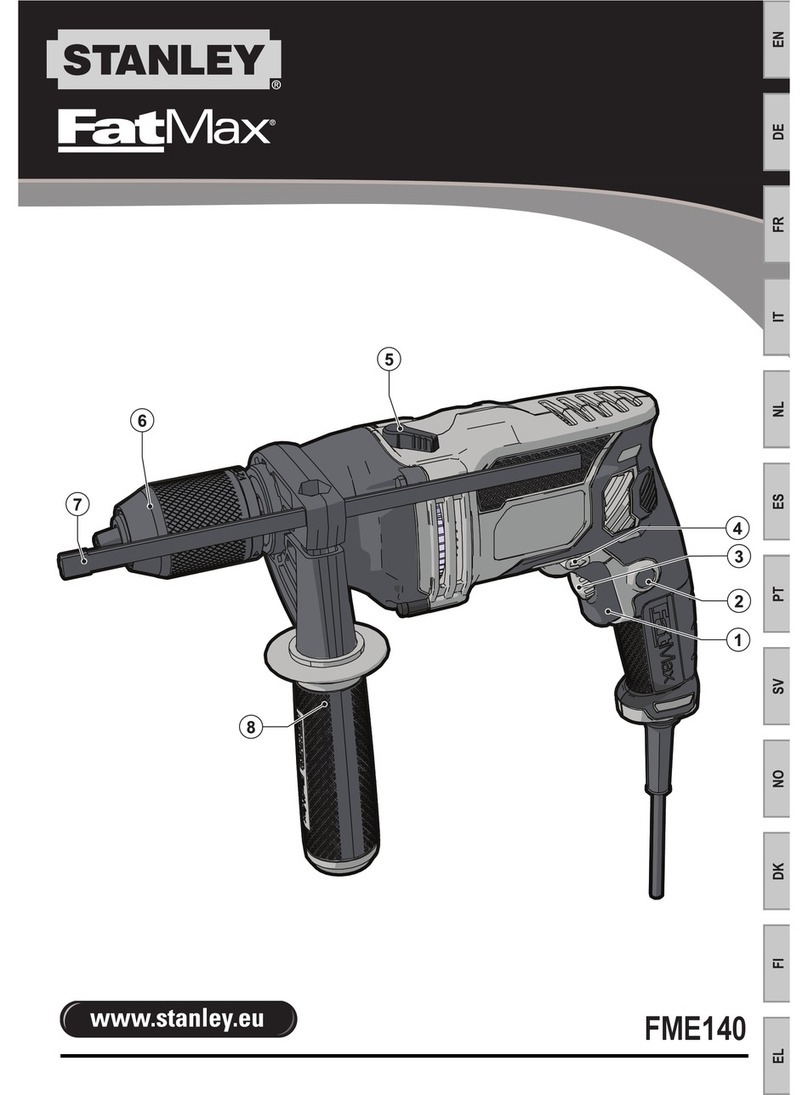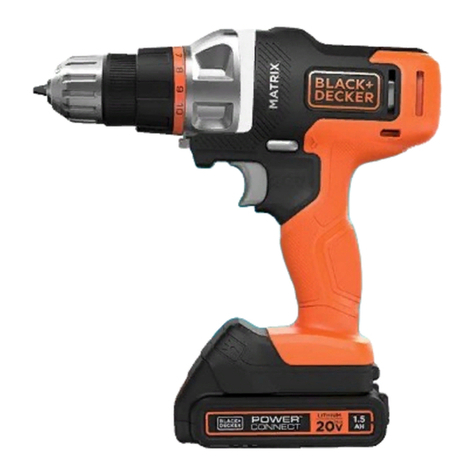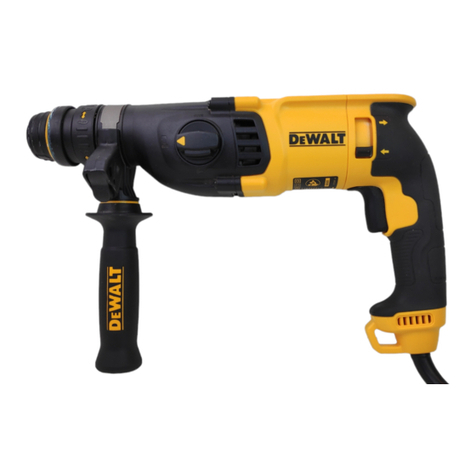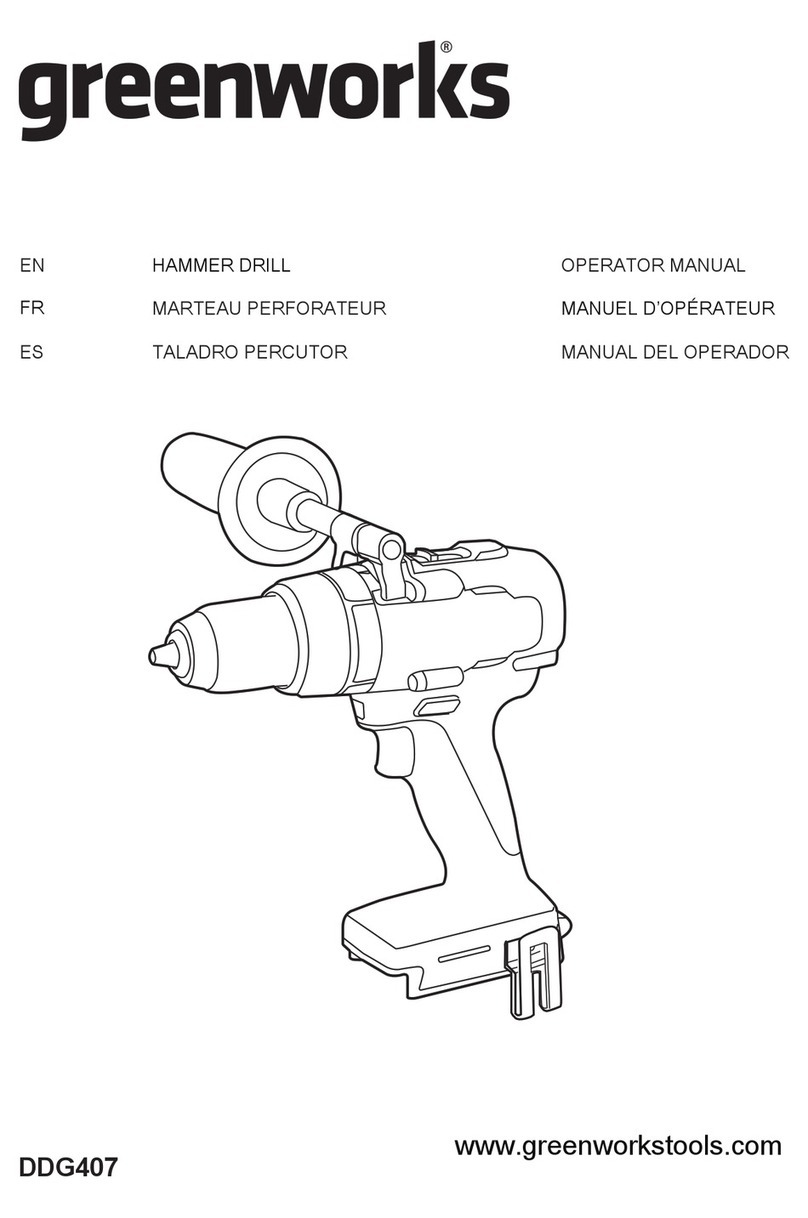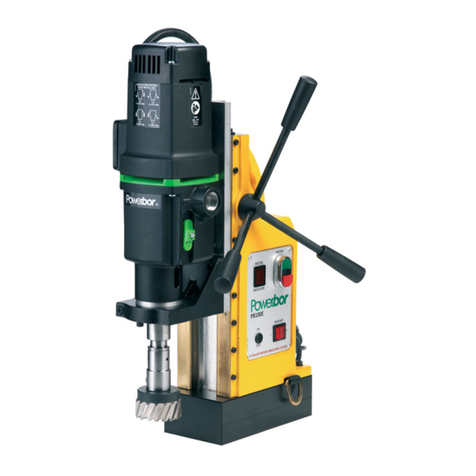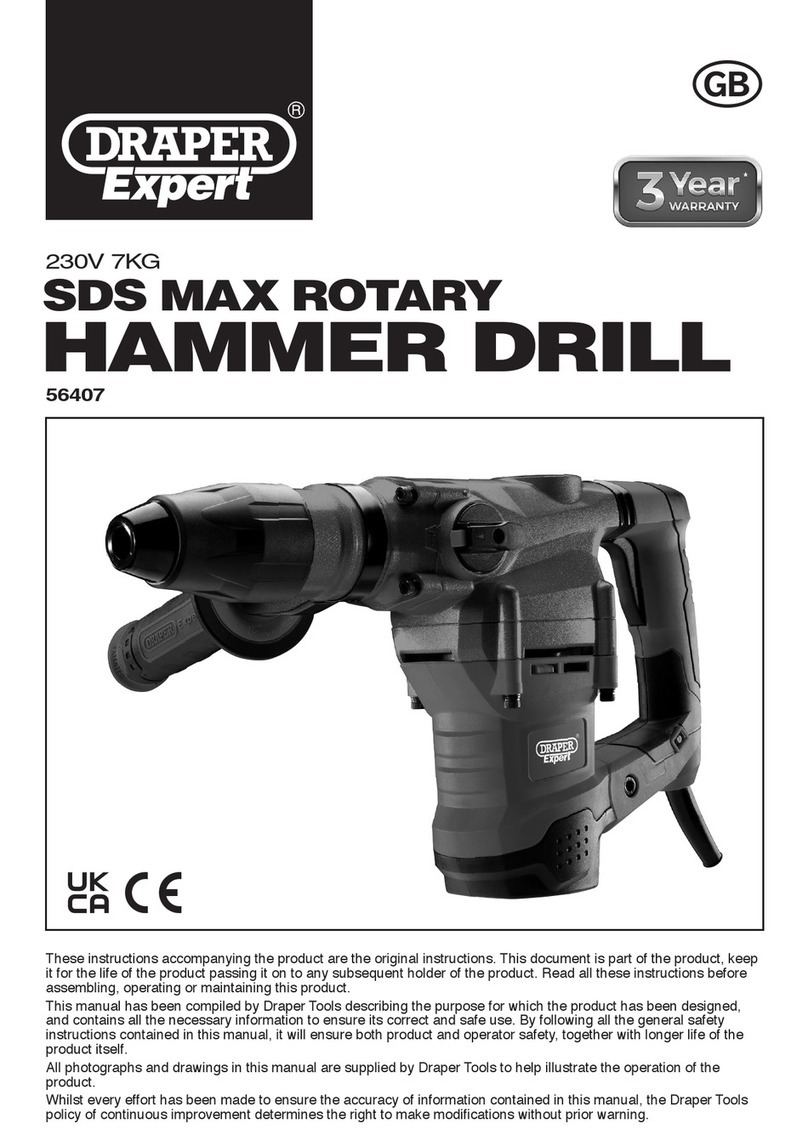
17
AANVULLENDE
VEILIGHEIDSVOORSCHRIFTEN
VOOR HET GEREEDSCHAP
1. Denk eraan dat dit gereedschap altijd gebruiks-
klaar is, omdat het niet op een stopcontact hoeft
te worden aangesloten.
2. Houd het gereedschap bij de geïsoleerde hand-
grepen vast wanneer u boort op plaatsen waar
het gereedschap met verborgen elektrische
bedrading in aanraking kan komen. Door contact
met een onder spanning staande draad, zullen
ook de niet-geïsoleerde metalen delen van het
gereedschap onder spanning komen te staan en
zal de gebruiker een elektrische schok krijgen.
3. Zorg ervoor dat u altijd stevige steun voor de
voeten hebt.
4. Controleer of er zich niemand beneden bevindt
wanneer u het gereedschap op een hoge plaats
gaat gebruiken.
5. Houd het gereedschap stevig vast.
6. Houd uw handen uit de buurt van roterende
onderdelen.
7. Laat het gereedschap niet achter terwijl het nog
in bedrijf is. Bedien het gereedschap alleen wan-
neer u het met de handen vasthoudt.
8. Raak de boor of het werkstuk niet aan onmiddel-
lijk na het gebruik; deze kunnen erg heet zijn en
brandwonden veroorzaken.
BEWAAR DEZE VOORSCHRIFTEN.
BEDIENINGSVOORSCHRIFTEN
Installeren of verwijderen van de accu (Fig. 1)
• Schakel het gereedschap altijd uit alvorens de accu te
installeren of te verwijderen.
• Om de accu te verwijderen, neemt u deze uit het
gereedschap terwijl u de knoppen aan beide zijden van
de accu indrukt.
• Om de accu te installeren, past u de rug op de accu in
de groef in de behuizing van het gereedschap, en dan
schuift u de accu naar binnen. Schuif de accu zo ver
mogelijk erin, totdat deze met een klikgeluid vergren-
delt. Indien u dit niet doet, kan de accu per ongeluk uit
het gereedschap vallen en uzelf of anderen verwon-
den.
• Als de accu moeilijk in de houder gaat, moet u niet pro-
beren hem met geweld erin te duwen. Indien de accu
er niet gemakkelijk ingaat, betekent dit dat u hem niet
op de juiste wijze erin steekt.
Installeren of verwijderen van de schroefbit of
boor (Fig. 2)
Belangrijk:
Controleer altijd of het gereedschap is uitgeschakeld en
de accu is verwijderd alvorens de boor te installeren of te
verwijderen.
Houd de ring vast en draai de bus naar links om de klau-
wen van de boorkop te openen. Steek de boor zo ver
mogelijk in de boorkop. Houd daarna de ring weer stevig
vast en draai de bus naar rechts om de boorkop vast te
zetten.
Om de boor te verwijderen, houdt u de ring vast en draait
u de bus naar links.
Werking van de trekschakelaar (Fig. 3)
LET OP:
Alvorens de accu in het gereedschap te plaatsen, moet u
altijd controleren of de trekschakelaar juist werkt en bij
het loslaten naar de “OFF” positie terugkeert.
Om het gereedschap in te schakelen, drukt u gewoon de
trekschakelaar in. Hoe dieper de trekschakelaar wordt
ingedrukt, hoe sneller het gereedschap draait. Om het
gereedschap uit te schakelen, de trekschakelaar losla-
ten.
Werking van de omkeerschakelaar (Fig.4)
LET OP:
• Controleer altijd de draairichting alvorens het gereed-
schap te gebruiken.
• Verander de stand van de omkeerschakelaar alleen
nadat het gereedschap volledig tot stilstand is geko-
men. Indien u de draairichting verandert terwijl de boor
nog draait, kan het gereedschap beschadigd raken.
• Zet de omkeerschakelaar altijd in de neutrale stand
wanneer u het gereedschap niet gebruikt.
Dit gereedschap heeft een omkeerschakelaar voor het
veranderen van de draairichting. Druk de omkeerschake-
laar in vanaf zijde A voor rechtse draairichting, of vanaf
zijde B voor linkse draairichting. Wanneer deze schake-
laar in de neutrale stand staat, kan de trekschakelaar niet
worden ingedrukt.
Veranderen van het toerental (Fig. 5)
Om het toerental te veranderen, schakelt u eerst het
gereedschap uit en dan schuift u de toerentalschakelaar
naar de “ΙΙ” zijde voor hoog toerental, of naar de “Ι” zijde
voor laag toerental. Zorg ervoor dat de toerentalschake-
laar in de juiste stand staat alvorens met het werk te
beginnen. Gebruik het toerental dat geschikt is voor uw
werk.
LET OP:
• Schuif de toerentalschakelaar altijd volledig naar de
juiste positie. Als u het gereedschap gebruikt met de
toerentalschakelaar halverwege tussen de “Ι” en “ΙΙ”
posities, kan het gereedschap beschadigd raken.
• Verschuif de toerentalschakelaar niet terwijl het
gereedschap draait. Hierdoor kan het gereedschap
beschadigd raken.
Instellen van het draaimoment (Fig. 6)
Het draaimoment kan worden ingesteld in 17 stappen
door de stelring zodanig te draaien dat zijn schaalverde-
lingen overeenkomen met de wijzer op het huis van het
gereedschap. Het draaimoment is minimaal wanneer het
cijfer 1 met de wijzer overeenkomt, en is maximaal wan-
neer de Amarkering met de wijzer overeenkomt.
Wanneer de stelring op een cijfer van 1 tot 16 is inge-
steld, zal de koppeling bij verschillende draaimomentni-
veaus slippen. De koppeling is ontworpen om niet te
slippen bij de Amarkering.
Alvorens met het eigenlijke werk te beginnen, moet u het
geschikte draaimoment bepalen door een proefschroef in
uw werkstuk of in een ander stuk van hetzelfde materiaal
te schroeven.
OPMERKING:
Gebruik het gereedschap niet met de stelring ingesteld
tussen het cijfer 16 en de Amarkering. Hierdoor kan het
gereedschap beschadigd raken.

